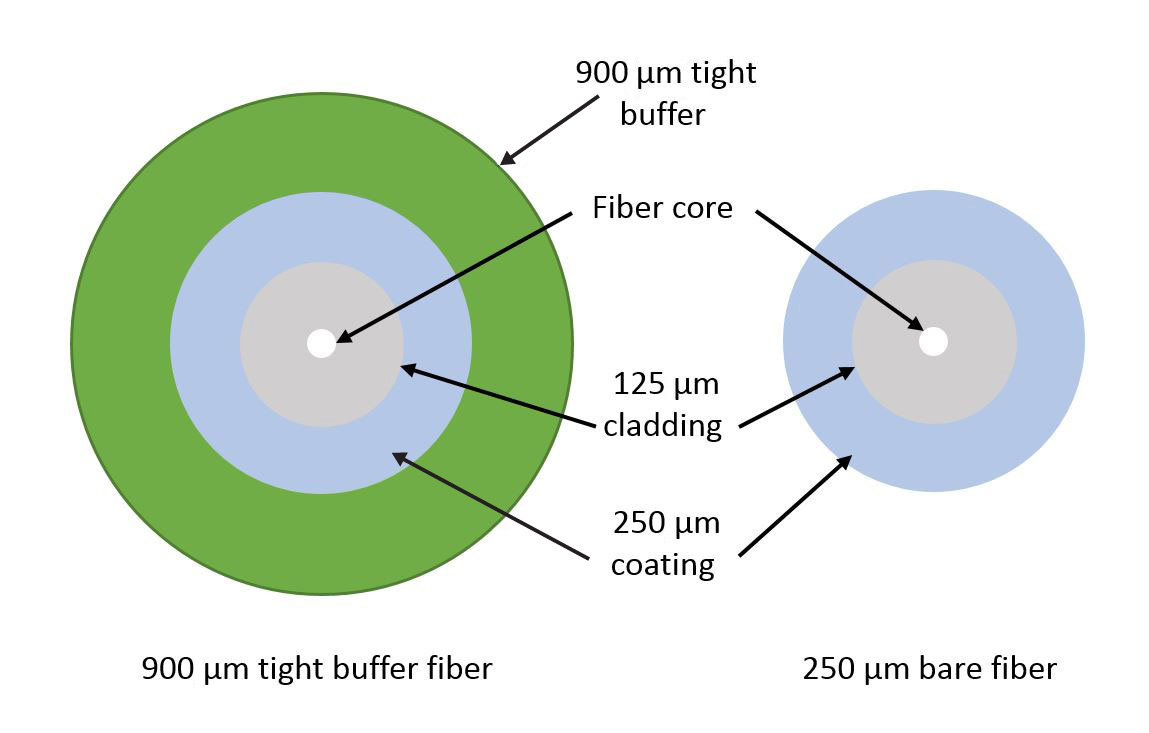Choosing the right fiber-optic cable has become more challenging than ever. Factors like the advent of new cable designs, suppliers, changes in fiber specifications, and the many claims of cable performance can confuse even the most seasoned network designers. However, the selection of the basic cable design is mostly dependent on the application and installation environment. There are two common styles of fiber optic cable constructions—loose-tube 250um loose-tube and 900um tight buffered fiber, but they are designed for different usage. So how to choose between them? This article may help you sort it out.
Construction of 250um Loose-Tube and 900um Tight Buffered Fiber
These two fibers begin with the same 250um bare fiber that features the same size fiber core (like 50um or 62.5um for MM fiber patch cords), 125um cladding and soft 250um coating. However, their main differences lie in the cable construction. As you can see in the following image, a 250um bare fiber or 250um loose tube fiber contains a fiber core, 125um cladding and 250um coating (soft plastic), which are often surrounded by gel and contained within a central tube or multiple of tubes around a central strength member. The fiber counts of loose-tube 250um fiber cable range from 6 to 144, and besides the 6-fiber cable, the fibers are also grouped into sets of 12 for maximum density.

As for the 900um tight buffered fiber, it also contains the fiber core, and 125um cladding, 250um coating and 900um tight buffer (hard plastic). Distinct from loose-tube 250um fiber, the tight buffer fiber is coated with 250/500/900um layers which is better suited to direct termination of the connectors. Typical use of tight buffered cables is for premise networking.
Main Features of Loose Tube and Tight Buffered Cable
- Loose Tube for Outdoor Conditions
Water Resistant—By utilizing gel filled tubes and water swelling tapes, loose tube cable provide maximum protection against water penetration and migration.
UV Resistant—Outer jacket contains carbon black which provides UV protection for applications involving exposure to direct sunlight.
Mechanical Resistant—To provide additional robustness, an armored layer can be provided. CST (corrugated steel tape), SWA (steel wire armor) or GRP (glass reinforced plastic) allow the cables to be protected in harsher environments and make them suitable for direct burial.
Lower cost—As these cables contain 250um fibers, loose tube generally are less expensive than those made to a tight buffered construction.
Duct space—Due to the cable construction, loose tube cables are nearly half the size of the tight buffered cable so that it will take less duct space than tight buffered cables especially for higher fiber counts contributing to overall lower installation costs
- Tight Buffered for Indoor Conditions
No need for gel—Indoor application eliminates the need to use protective gel allowing them suitable for installing vertically through building risers
Flexibility—No stiff strength member is needed, making the cable more flexible. The cable is also ‘tight bound’ allowing it to be pulled around multiple bends or hung vertically without causing ‘fiber axial migration’.
Aramid Yarns—The most popular aramid yarns used in fiber optic cables are e-glass. E-glass is primarily used for measures against rodent damage as the e-glass splinters when severed.
Easy splicing—The 900um jacket makes the handling of each core easier and is less fragile than 250um. Tight-buffered cables are easier to install because there’s no messy gel to clean up and they don’t require a fan-out kit for splicing or termination. You can crimp connectors directly to each fiber.
From Outdoor to Indoor
After going through the main features of these two cable types, now you may wonder, What do I do if I need to use the cable both for indoor and outdoor environment? Why can loose-tube and tight-buffered cables be used for outdoor, indoors applications, respectively? Fortunately, design and materials have evolved to meet the needs of indoor/outdoor applications with a variety of cable choices. The most prevalent choice today is a loose-tube, gel-filled, riser-rated cable. This design offers all the proper outdoor protection, and the riser rating allows it to be run within the building (except in the horizontal). There are also loose-tube plenum-rated cables available.
Loose-tube cores are best-suited for armored outdoor applications, double-jacketing for more severe environments, and in figure-eight and all-dielectric self-supporting designs. Tight-buffered designs often do not have anti-buckling elements and do not decouple the fiber from extreme stresses, such as the material contractions that are experienced at extremely cold temperatures. This is why loose-tube cables are so widely accepted for use in outdoor environments.
Tight-buffered cable designs typically offer a smaller package and more flexible cable. The 900-micron buffered fiber is easier to connectorize, and the cable is generally easier to prepare for termination. These cables do not typically provide protection from water migration and do not isolate fibers well from the expansion and contraction of other materials due to temperature extremes. Tight-buffered cables, often called premise or distribution cables, are ideally suited for indoor-cable runs.
Conclusion
To select the right fiber optic cable, there are more than one type of cables that may fit the bill for many applications. In that case, other factors such as ease of use, size, and cost will be added to the evaluation and selection process. Generally speaking, tight-buffered 900um fiber cables are used for indoor applications, including intra-building riser and plenum applications and in the data center. Loose-tube 250um fiber cables are typically used in outside plant (OSP) applications, such as inter-building duct, aerial and direct buried installations. FS.COM offers a full range of fiber optic cables including 250um loose-tube, 900um tight buffered cables, LC LC single mode patch cord. Besides, optical transceivers are also provided at low price and high quality.
评论
发表评论